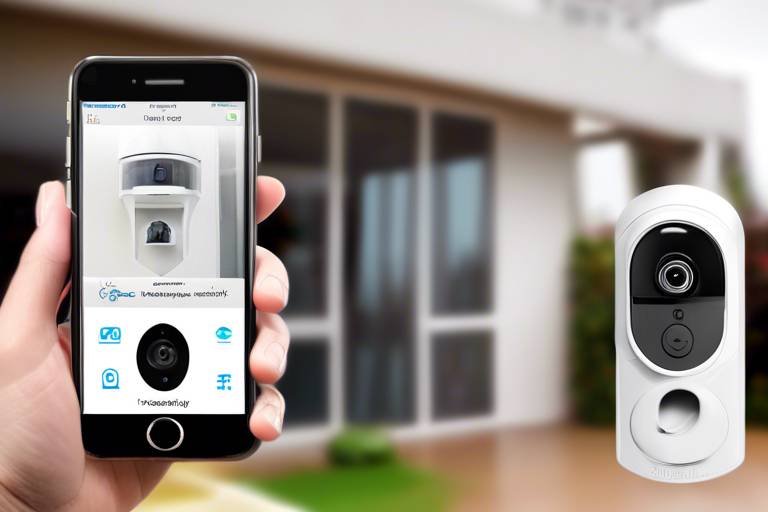Innovations in Smart Textiles
In recent years, the world of textiles has undergone a remarkable transformation, thanks to the integration of technology into fabrics. This exciting field, known as smart textiles or e-textiles, is not just about fashion; it’s about creating materials that can interact with their environment and provide enhanced functionality. Imagine wearing a shirt that can monitor your heart rate or a pair of socks that can track your foot movements during a run! These innovations are revolutionizing various industries, from healthcare to sports, and even fashion. Let’s dive deeper into what smart textiles are, their applications, and the incredible benefits they bring.
Smart textiles are defined as fabrics that have been enhanced with technologies that enable them to sense and respond to environmental stimuli. They can be categorized into several types, including:
- Passive Smart Textiles: These fabrics react to environmental changes but do not actively change their properties.
- Active Smart Textiles: These textiles can change their properties based on external stimuli, such as temperature or moisture.
- Very Smart Textiles: These include textiles that can process data and respond intelligently, often integrating microelectronics.
The applications of smart textiles are vast. In healthcare, they can monitor vital signs, while in sports, they help track performance metrics. The fashion industry is also tapping into this technology, creating clothing that not only looks good but also offers practical benefits. The potential is limitless, and as technology advances, so too will the capabilities of smart textiles.
One of the most transformative applications of smart textiles is in the healthcare sector. These innovative fabrics can significantly improve patient care by providing continuous monitoring of vital signs, such as heart rate and body temperature. For instance, imagine a hospital gown embedded with sensors that can alert medical staff if a patient’s condition deteriorates. This kind of technology not only enhances patient safety but also streamlines medical practices, allowing healthcare providers to focus on what truly matters—patient care.
Wearable health monitors integrated into smart textiles are paving the way for a new era in preventive healthcare. These devices allow for continuous monitoring of health metrics, providing real-time data that can be crucial for early diagnosis and intervention. For example, a smart shirt could track breathing patterns and alert the wearer or their doctor if any irregularities are detected. This proactive approach to health monitoring can lead to better health outcomes and lower healthcare costs.
Smart textiles are also making waves in the realm of rehabilitation. They can provide support and feedback during recovery processes, enhancing physical therapy outcomes. Imagine wearing a smart bandage that not only protects a wound but also monitors the healing process and provides data to healthcare professionals. This kind of innovation allows for tailored rehabilitation programs that can adapt to the patient’s needs, ultimately speeding up recovery time and improving overall health.
In the world of sports, smart textiles are changing the game for athletes. These innovative fabrics enhance performance by providing crucial data that can inform training and competition strategies. Athletes can wear garments that monitor their movements, heart rate, and even sweat levels, allowing them to optimize their performance like never before.
Smart textiles equipped with sensors offer real-time data on an athlete's performance. This information can be invaluable in optimizing training regimens, helping athletes to identify areas for improvement and track their progress over time. For instance, a runner could wear smart leggings that provide feedback on their running form, helping them to run more efficiently and effectively.
Injury prevention is another key benefit of smart textiles. By offering insights into body mechanics, these innovations help athletes avoid injuries during training and competition. For example, a smart shirt could analyze posture and movement patterns, alerting the wearer to potential risks before an injury occurs. This proactive approach can save athletes from the pain and setbacks associated with injuries, allowing them to stay in peak condition.
Despite their incredible potential, smart textiles do face several challenges. Issues such as durability, cost, and the complexity of integrating technology into fabrics remain significant hurdles. However, ongoing research is focused on overcoming these limitations, paving the way for more robust and affordable solutions in the future.
The future of smart textiles is undoubtedly bright. With advancements in technology and materials, we can expect to see even more innovative applications emerge. From self-cleaning fabrics to textiles that can change color based on mood, the possibilities are endless. As we continue to explore this exciting field, one thing is clear: smart textiles are here to stay, and they will play a pivotal role in shaping our future.
- What are smart textiles? Smart textiles are fabrics that incorporate technology to interact with their environment, providing enhanced functionality.
- How are smart textiles used in healthcare? They can monitor vital signs, aid in rehabilitation, and improve patient care through continuous health tracking.
- Can smart textiles prevent injuries in sports? Yes, they can provide insights into body mechanics to help athletes avoid injuries during training and competition.
- What are the challenges facing smart textiles? Durability, cost, and technology integration are significant challenges that researchers are currently addressing.

Overview of Smart Textiles
Smart textiles, often referred to as e-textiles, represent a revolutionary fusion of traditional fabrics and cutting-edge technology. Imagine wearing a shirt that can monitor your heart rate or a pair of socks that tracks your foot pressure while you walk. This is not science fiction; it's the reality of smart textiles! These innovative materials are designed to interact with their environment, providing enhanced functionality that goes far beyond the capabilities of conventional fabrics.
At their core, smart textiles can be categorized into two main types: passive and active textiles. Passive smart textiles are designed to sense environmental changes without altering their form or function. For instance, they can change color in response to temperature shifts or provide UV protection when exposed to sunlight. On the other hand, active smart textiles not only sense environmental changes but also respond to them by altering their properties. This could mean adjusting insulation levels based on external temperatures or even generating electricity through body movement.
The potential applications of smart textiles are vast and varied, spanning multiple industries. In the fashion sector, designers are experimenting with fabrics that can change patterns or colors on demand, creating garments that are not only stylish but also interactive. In healthcare, smart textiles are being used to develop wearable devices that monitor vital signs, improving patient care and enabling real-time health tracking. Sports professionals are also leveraging these technologies to enhance performance, using textiles that provide feedback on body mechanics and help prevent injuries.
Despite their innovative nature, smart textiles are still in the early stages of adoption. Challenges such as durability, washability, and cost-effectiveness must be addressed before they can become mainstream. However, ongoing research and development are paving the way for more resilient and affordable solutions. As we look to the future, the possibilities for smart textiles seem limitless, promising a world where our clothing not only looks good but also works hard for us.
In summary, smart textiles are not just a fleeting trend; they are a glimpse into the future of how we interact with the world around us. With their ability to combine functionality with style, they are set to transform various industries, making our lives easier, healthier, and more connected.

Applications in Healthcare
Smart textiles are revolutionizing the healthcare industry, introducing a wave of innovations that are transforming patient care and medical practices. By integrating technology directly into fabrics, these textiles can monitor vital signs, provide therapeutic support, and even facilitate rehabilitation. Imagine wearing a shirt that not only keeps you comfortable but also tracks your heart rate, temperature, and even your stress levels. This is the power of smart textiles in healthcare!
One of the most exciting applications of smart textiles is in the realm of wearable health monitors. These garments are embedded with sensors that continuously gather data on various health metrics. For instance, a smart shirt can monitor your heart rate and send alerts if it detects any abnormalities. This real-time data collection is invaluable for preventive healthcare, allowing for early intervention and potentially saving lives. The convenience of wearing a simple piece of clothing that does all this is groundbreaking!
Furthermore, the role of smart textiles extends beyond monitoring to include rehabilitation and recovery. After surgery or injury, patients often undergo physical therapy to regain strength and mobility. Smart textiles can enhance this process by providing real-time feedback on the patient's movements. For example, a smart bandage can not only protect a wound but also monitor the healing process and alert healthcare providers if there are any complications. This integration of technology into rehabilitation practices ensures that patients receive the best possible care tailored to their individual needs.
To illustrate the impact of smart textiles in healthcare, consider the following table that summarizes the key benefits:
| Application | Benefits |
|---|---|
| Wearable Health Monitors | Continuous monitoring, early detection of health issues, personalized health insights. |
| Rehabilitation Support | Real-time feedback, improved recovery outcomes, tailored therapy sessions. |
| Smart Bandages | Wound monitoring, infection detection, enhanced healing support. |
As we look to the future, the potential for smart textiles in healthcare is enormous. They not only promise to improve patient outcomes but also to streamline medical practices, reducing the burden on healthcare professionals. Imagine a world where hospitals are equipped with smart fabrics that can monitor patients remotely, allowing healthcare providers to focus on critical care rather than routine checks. The possibilities are endless, and the journey has only just begun!
In conclusion, smart textiles are not just a trend; they are a significant advancement in healthcare technology. Their ability to monitor health metrics, support rehabilitation, and enhance patient care makes them an essential component of modern medicine. As research continues and technology evolves, we can expect even more innovative applications that will further improve the quality of healthcare.
- What are smart textiles?
Smart textiles are fabrics that have been designed with technology to interact with the environment, offering functionalities beyond traditional textiles. - How do smart textiles monitor health?
They use embedded sensors to continuously collect and transmit health data, which can be monitored in real-time by healthcare professionals. - Are smart textiles safe for everyday use?
Yes, smart textiles are designed to be safe and comfortable for regular wear, and they undergo rigorous testing to ensure their safety. - What is the future of smart textiles in healthcare?
The future holds immense potential, with advancements in materials and technology expected to create even more innovative applications in patient care and monitoring.

Wearable Health Monitors
Wearable health monitors are at the forefront of the smart textile revolution, seamlessly integrating technology into our daily lives. Imagine a fabric that not only keeps you warm but also tracks your heart rate, monitors your blood pressure, and even alerts you to potential health issues—all while you go about your day. This is not science fiction; it's the reality of smart textiles that are designed to improve our health and well-being.
These innovative fabrics are embedded with advanced sensors that collect real-time data about the wearer’s health metrics. For instance, a shirt woven with smart fibers can continuously monitor your heart rate, providing crucial information to both the wearer and healthcare professionals. This level of monitoring is particularly beneficial for individuals with chronic conditions, allowing for timely interventions and reducing the need for frequent hospital visits.
One of the standout features of these wearable health monitors is their ability to facilitate preventive healthcare. By keeping track of vital signs, users can identify potential health issues before they escalate. Think of it like having a personal health assistant that never sleeps. This constant vigilance can lead to early detection of conditions such as hypertension or arrhythmias, which can significantly improve treatment outcomes.
Furthermore, the data collected by these smart textiles can be easily shared with healthcare providers through mobile applications. This feature not only enhances communication between patients and doctors but also allows for personalized treatment plans based on accurate, real-time data. The implications for patient care are profound, as this technology can lead to more informed decisions and tailored healthcare strategies.
However, the journey of wearable health monitors isn't without its challenges. Issues related to data privacy and the accuracy of the readings are ongoing concerns. Patients must trust that their sensitive health information is secure, and healthcare providers need to ensure that the data they receive is reliable. As technology advances, researchers are continually working to address these challenges, ensuring that wearable health monitors are both effective and secure.
In summary, wearable health monitors represent a significant leap forward in how we approach personal health management. With the potential to transform preventive healthcare, these smart textiles are paving the way for a future where individuals have greater control over their health. As we continue to explore the possibilities of smart textiles, the integration of wearable health monitors will undoubtedly play a crucial role in shaping the landscape of modern healthcare.

Rehabilitation and Recovery
In the realm of rehabilitation and recovery, smart textiles are revolutionizing how patients regain their strength and mobility. Imagine wearing a fabric that not only supports your movements but also communicates vital information about your recovery process! These innovative textiles are embedded with sensors and conductive materials that monitor a patient's physical state in real-time, providing invaluable feedback to both the wearer and healthcare professionals.
One of the most significant advantages of smart textiles in rehabilitation is their ability to offer real-time feedback. For instance, a patient recovering from knee surgery can wear a smart knee brace that tracks their range of motion and muscle activity. This data is transmitted to a mobile app or directly to a healthcare provider, allowing for personalized adjustments to their rehabilitation program. With this technology, healthcare professionals can make informed decisions more quickly, optimizing recovery plans tailored to each individual.
Additionally, smart textiles can help motivate patients during their recovery journey. By incorporating gamification elements, such as progress tracking and rewards for reaching milestones, these textiles transform the often tedious process of rehabilitation into an engaging experience. Patients are more likely to adhere to their therapy routines when they can see tangible progress and receive instant feedback on their efforts.
Furthermore, the integration of smart textiles into rehabilitation extends beyond just physical recovery. The psychological aspect of healing is also addressed. For example, biofeedback mechanisms embedded in smart fabrics can help patients manage pain and anxiety. By providing insights into physiological responses, such as heart rate and muscle tension, patients can learn techniques to control their stress levels, making the recovery process more holistic.
As we look to the future, the potential for smart textiles in rehabilitation is immense. Ongoing research is focused on enhancing the durability and functionality of these materials, making them even more effective in clinical settings. The ultimate goal is to create textiles that not only support physical recovery but also adapt to the user's needs over time, ensuring a seamless transition from rehabilitation to everyday life.
In summary, smart textiles are not just a passing trend; they represent a significant leap forward in the way we approach rehabilitation and recovery. By combining technology with compassionate care, these innovations are paving the way for a future where recovery is more efficient, personalized, and ultimately successful.
- What are smart textiles? Smart textiles are fabrics that incorporate technology to interact with the environment, providing enhanced functionality such as monitoring health metrics.
- How do smart textiles aid in rehabilitation? They offer real-time feedback, track progress, and can motivate patients through gamification, enhancing the recovery experience.
- Are smart textiles comfortable to wear? Yes, advancements in technology have made smart textiles lightweight and comfortable, allowing for everyday wear during rehabilitation.
- Can smart textiles help prevent injuries? Absolutely! By providing insights into body mechanics, they can help athletes and patients avoid injuries during recovery and training.

Impact on Sports Performance
In the fast-paced world of sports, every second counts, and athletes are constantly on the lookout for ways to enhance their performance. Enter smart textiles—a game changer that has revolutionized how athletes train, compete, and recover. These innovative fabrics, embedded with advanced sensors and technology, provide real-time data that not only helps in monitoring performance but also in making informed decisions that can lead to victory.
Imagine wearing a shirt that tracks your heart rate, temperature, and even your muscle activity as you sprint towards the finish line. This is the reality that smart textiles bring to athletes today. The integration of technology into sportswear allows for a deeper understanding of one’s body and performance metrics. As a result, athletes can tailor their training regimens to maximize efficiency and effectiveness.
One of the most significant impacts of smart textiles is in performance tracking. These textiles come equipped with sensors that collect data on various parameters such as speed, endurance, and strength. With this data, athletes can analyze their performance in real time, identifying areas for improvement. For instance, a runner can assess their stride length and frequency, enabling them to make adjustments on the fly. This immediate feedback loop is akin to having a personal coach available at all times, guiding athletes towards their peak performance.
Moreover, smart textiles play a vital role in injury prevention. By providing insights into body mechanics, these textiles help athletes understand their movements better. For example, they can detect irregular patterns or excessive strain on certain muscles, alerting athletes to potential injuries before they occur. This is crucial, as injuries can sideline athletes for extended periods, affecting their careers and performance. With smart textiles, the motto “prevention is better than cure” truly comes to life.
As we delve deeper into the impact of smart textiles on sports performance, it's essential to recognize the collaborative nature of this technology. Athletes, coaches, and sports scientists work hand-in-hand to interpret the data collected from these smart fabrics. The insights gained not only help in individual training but also contribute to team strategies and overall performance enhancement. The synergy between human effort and technological innovation has created a new paradigm in sports.
In summary, the impact of smart textiles on sports performance is profound and multifaceted. From real-time performance tracking to injury prevention, these innovations are reshaping the athletic landscape. As technology continues to evolve, we can only imagine the heights that athletes will reach with the help of smart textiles. The future of sports is undoubtedly intertwined with the advancements in these remarkable fabrics.
- What are smart textiles? Smart textiles are fabrics that have been embedded with technology to enable them to interact with the environment, providing enhanced functionality.
- How do smart textiles enhance sports performance? They provide real-time data on performance metrics, allowing athletes to adjust their training and prevent injuries.
- Are smart textiles expensive? While initial costs may be higher than traditional fabrics, the long-term benefits in performance and injury prevention can justify the investment.
- Can anyone use smart textiles? Yes, while they are particularly beneficial for athletes, anyone interested in fitness can use smart textiles for better monitoring and improvement.

Performance Tracking
When it comes to enhancing athletic performance, smart textiles are revolutionizing the way athletes train and compete. Imagine wearing a fabric that not only feels comfortable but also acts as a personal coach, providing real-time feedback on your performance. This is the magic of performance tracking through smart textiles. These innovative fabrics are embedded with sensors that monitor various metrics, such as heart rate, body temperature, and even muscle activity. The data collected can be analyzed to gain insights into an athlete's performance, helping them make informed decisions about their training regimen.
One of the most exciting aspects of performance tracking is its ability to provide real-time data. Athletes can receive immediate feedback on their performance metrics, allowing them to adjust their training on the fly. For instance, if a runner's heart rate exceeds a certain threshold, they can slow down or modify their pace to avoid overexertion. This kind of immediate insight is invaluable, particularly in high-stakes environments like competitions where every second counts.
Moreover, performance tracking through smart textiles can lead to more personalized training programs. Coaches and athletes can analyze the data to identify strengths and weaknesses, tailoring workouts to focus on specific areas that need improvement. For example, if a cyclist's data reveals that their power output is inconsistent, adjustments can be made to their training to enhance endurance or speed. This level of customization not only optimizes performance but also reduces the risk of injuries, as athletes can train smarter rather than harder.
To illustrate the impact of smart textiles on performance tracking, consider the following table that outlines key metrics monitored by these innovative fabrics:
| Metric | Description | Benefits |
|---|---|---|
| Heart Rate | Monitors the athlete's heart rate in real-time. | Helps in maintaining optimal training intensity. |
| Body Temperature | Tracks changes in body temperature during activity. | Prevents overheating and dehydration. |
| Muscle Activity | Measures muscle engagement and fatigue levels. | Guides recovery and reduces injury risk. |
In addition to these metrics, smart textiles can also facilitate longitudinal studies on an athlete's performance over time. By collecting data consistently, athletes and coaches can observe trends and patterns, leading to more effective long-term training strategies. This is akin to having a detailed map of your journey, allowing you to navigate your training path with precision and purpose.
In conclusion, performance tracking through smart textiles is not just a technological advancement; it's a game-changer for athletes looking to push their limits. With the ability to monitor vital metrics in real-time, personalize training programs, and reduce injury risks, these innovative fabrics are paving the way for the future of sports performance. As technology continues to evolve, we can expect even more sophisticated applications that will further enhance the athletic experience, making every workout count.
- What are smart textiles? Smart textiles are fabrics that incorporate technology to interact with the environment and provide enhanced functionality.
- How do smart textiles improve athletic performance? They provide real-time data on various performance metrics, allowing athletes to optimize their training and reduce injury risks.
- Are smart textiles durable? While durability is a challenge, ongoing research is focused on creating more resilient materials that can withstand rigorous use.
- What metrics can smart textiles track? Common metrics include heart rate, body temperature, and muscle activity, among others.

Injury Prevention
In the world of sports, injury prevention is a game-changer, and smart textiles are stepping up to the plate in a big way. Imagine wearing a fabric that not only feels comfortable but also acts as your personal coach, providing real-time insights into your body mechanics. Smart textiles are equipped with advanced sensors that can track various metrics such as muscle strain, joint angles, and even temperature fluctuations. This data is invaluable for athletes who want to push their limits while minimizing the risk of injury.
One of the most significant advantages of smart textiles in injury prevention is their ability to provide real-time feedback. For instance, if an athlete is running and their foot strikes the ground with excessive force, the smart fabric can alert them to adjust their technique. This immediate feedback allows athletes to make quick corrections, reducing the likelihood of strains or sprains. It's like having a coach whispering in your ear, guiding you to perform at your best while keeping you safe.
Moreover, smart textiles can monitor an athlete's fatigue levels. As we know, fatigue is a major contributor to injuries. When an athlete is tired, their form often deteriorates, leading to improper movements that can cause harm. By analyzing data related to heart rate, muscle tension, and even sweat levels, these textiles can indicate when it's time to take a break or modify the training intensity. This proactive approach not only helps in preventing injuries but also enhances overall performance.
To illustrate the effectiveness of smart textiles in injury prevention, consider the following table that summarizes key benefits:
| Benefit | Description |
|---|---|
| Real-Time Feedback | Provides immediate insights into body mechanics to correct form and technique. |
| Fatigue Monitoring | Tracks fatigue levels, helping athletes avoid overexertion and related injuries. |
| Data-Driven Decisions | Enables athletes and coaches to make informed training decisions based on real data. |
In addition to these benefits, smart textiles can also facilitate rehabilitation for athletes recovering from injuries. By continuously monitoring the healing process, these textiles can provide feedback on muscle recovery and overall readiness to return to the field. This not only helps in preventing re-injury but also ensures that athletes are physically prepared for the demands of their sport.
However, while the potential of smart textiles in injury prevention is tremendous, it's essential to acknowledge that they are not a one-size-fits-all solution. Athletes must still prioritize proper training techniques and listen to their bodies. Smart textiles are a tool, but they work best when combined with traditional training methods and a solid understanding of personal limits.
In conclusion, the integration of smart textiles into sports gear is revolutionizing the way athletes approach injury prevention. By providing real-time feedback, monitoring fatigue, and facilitating rehabilitation, these innovative fabrics are helping athletes stay safe while achieving peak performance. As technology continues to advance, we can only expect these textiles to become even more sophisticated, offering even greater insights into the complex world of human movement.
- What are smart textiles? Smart textiles are fabrics that incorporate technology to interact with the environment, providing enhanced functionality.
- How do smart textiles help in injury prevention? They provide real-time feedback on body mechanics and monitor fatigue levels, helping athletes adjust their training to avoid injuries.
- Can smart textiles be used in rehabilitation? Yes, they can monitor recovery progress and provide insights to ensure athletes are ready to return to their sport safely.
- Are smart textiles expensive? While the initial cost may be higher than traditional fabrics, the long-term benefits in injury prevention and performance can outweigh the investment.

Challenges and Limitations
While the world of smart textiles is brimming with potential, it's not without its challenges and limitations. As exciting as these innovations are, they face several hurdles that could slow down their widespread adoption. One of the most pressing issues is durability. Traditional fabrics are designed to withstand wear and tear, but when you introduce technology into the mix, things get a bit more complicated. The sensors and circuits embedded in smart textiles can be sensitive to moisture, heat, and physical stress, which may lead to malfunctions over time.
Another significant challenge is the cost of production. Creating these advanced textiles often requires specialized materials and intricate manufacturing processes, which can drive up prices. This is particularly concerning for industries like fashion, where affordability is key. As a result, many consumers may find themselves hesitant to invest in smart clothing, especially when traditional options are available at a fraction of the cost.
Moreover, there is the issue of data privacy. Smart textiles often collect sensitive health information, and this raises questions about how that data is stored, shared, and protected. Consumers may be wary of wearing garments that track their health metrics, fearing that their personal information could be compromised. This concern can hinder the acceptance of smart textiles in healthcare and fitness applications.
Additionally, the integration of smart textiles into existing systems can be a logistical nightmare. For instance, healthcare providers may need to invest in new infrastructure to support the data collected by these textiles, which can be a significant barrier to entry. This leads to a cascading effect where the adoption rate is slowed, and the potential benefits of smart textiles are not fully realized.
Despite these challenges, ongoing research is being conducted to address these limitations. Scientists and engineers are working tirelessly to develop more durable materials, reduce production costs, and enhance data security. As innovations continue to emerge, the future of smart textiles looks increasingly bright. It’s a classic case of overcoming obstacles to reach new heights!
- What are smart textiles? Smart textiles are fabrics that have been enhanced with technology to provide interactive features.
- How do smart textiles benefit healthcare? They enable continuous health monitoring and can assist in rehabilitation, improving patient care.
- What are the main challenges facing smart textiles? Key challenges include durability, cost, data privacy, and integration into existing systems.
- Will smart textiles become more affordable in the future? Ongoing research aims to lower production costs, which may lead to more affordable options for consumers.

Future Trends in Smart Textiles
As we gaze into the crystal ball of innovation, the future of smart textiles appears not just bright but dazzling! With technology evolving at lightning speed, the next generation of smart fabrics promises to revolutionize numerous sectors, from fashion to healthcare. Imagine a world where your clothing not only looks good but also monitors your health, adjusts to your environment, and even communicates with other devices. Sounds like science fiction? Well, it’s becoming a reality!
One of the most exciting trends is the integration of AI and machine learning into smart textiles. These advancements will enable fabrics to learn from their users' behaviors and adapt accordingly. For instance, a running shirt could analyze your performance over time and suggest optimal training regimens or recovery techniques. This level of personalization could significantly enhance both athletic performance and overall well-being.
Moreover, the development of biodegradable smart textiles is on the rise. With growing concerns about environmental sustainability, researchers are focusing on creating fabrics that are not only smart but also eco-friendly. These biodegradable materials would reduce waste and minimize the environmental impact of textile production. Imagine wearing a shirt that not only tracks your fitness but also decomposes naturally at the end of its life cycle!
Another trend to watch is the rise of embedded sensors that are more advanced and less intrusive. Future smart textiles will feature ultra-thin sensors seamlessly integrated into the fabric, making them virtually invisible to the naked eye. This will enhance comfort while maintaining functionality. Athletes will benefit from real-time feedback without the bulk of traditional wearable devices, allowing them to perform at their best without distractions.
Furthermore, the connectivity of smart textiles will expand dramatically. With the advent of the Internet of Things (IoT), we can expect our clothes to communicate not only with our smartphones but also with our home automation systems. Picture this: your jacket senses that it's getting cold outside and sends a signal to your home to adjust the thermostat before you arrive. This level of integration could redefine how we interact with our environment.
In terms of healthcare, the future holds incredible promise as smart textiles evolve to include diagnostic capabilities. Imagine a bandage that can monitor wound healing and alert healthcare providers if there are signs of infection. Such innovations could lead to more proactive medical care and significantly improve patient outcomes.
To sum it up, the future of smart textiles is not just about enhancing functionality; it’s about creating a seamless blend of technology and daily life. As we continue to innovate and push boundaries, we can expect smart textiles to become an integral part of our lives, enhancing comfort, health, and performance in ways we are only beginning to understand.
- What are smart textiles? Smart textiles are fabrics that incorporate technology to provide enhanced functionality, such as monitoring health metrics or adapting to environmental conditions.
- How do smart textiles work? They work by embedding sensors and electronic components into the fabric, allowing them to interact with the environment and the wearer.
- What industries benefit from smart textiles? Industries such as healthcare, fashion, and sports are seeing significant advancements and applications of smart textiles.
- Are smart textiles environmentally friendly? Many researchers are working on creating biodegradable smart textiles to reduce environmental impact.
- What is the future of smart textiles? The future includes advancements in AI integration, enhanced connectivity, and diagnostic capabilities, making smart textiles an integral part of everyday life.
Frequently Asked Questions
- What are smart textiles?
Smart textiles, also known as e-textiles, are fabrics that have been enhanced with technology. They can interact with the environment, offering improved functionality such as sensing, monitoring, and even responding to various stimuli.
- How are smart textiles used in healthcare?
In healthcare, smart textiles are revolutionizing patient care. They are used in wearable health monitors that continuously track vital signs, and in rehabilitation garments that provide support and feedback, aiding recovery and improving treatment outcomes.
- Can smart textiles improve sports performance?
Absolutely! Smart textiles equipped with sensors provide real-time data on an athlete's performance, helping them optimize their training regimens. Additionally, they can offer insights into body mechanics, which is crucial for injury prevention.
- What are some challenges faced by smart textiles?
Despite their potential, smart textiles face several challenges, including issues related to durability, cost, and the integration of technology into fabric. Ongoing research is focused on overcoming these limitations to enhance their usability and accessibility.
- What does the future hold for smart textiles?
The future of smart textiles is bright, with advancements in technology and materials on the horizon. Emerging trends suggest that we will see even more innovative applications across various industries, from fashion to healthcare and beyond.
- Are smart textiles comfortable to wear?
Yes! While early versions of smart textiles may have been bulky or uncomfortable, advancements in technology are leading to more lightweight, breathable, and flexible options that can be worn comfortably throughout the day.
- How do smart textiles monitor health?
Smart textiles monitor health through embedded sensors that collect data on various metrics such as heart rate, temperature, and movement. This data is then transmitted to a connected device for analysis, helping users track their health in real-time.
- Are smart textiles expensive?
While the cost of smart textiles can vary, they are generally more expensive than traditional fabrics due to the technology involved. However, as the technology matures and production scales up, prices are expected to decrease, making them more accessible.
- Can smart textiles be washed?
Yes, many smart textiles are designed to be washable. However, it's essential to follow the manufacturer's care instructions to ensure the longevity and functionality of the embedded technology.



















